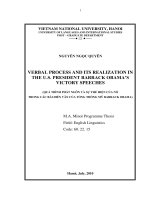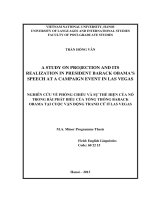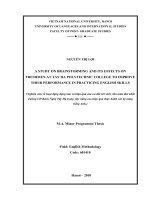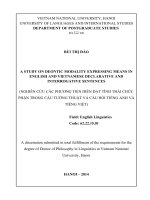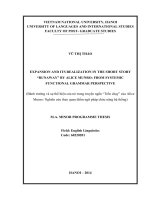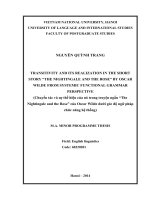A study on projection and its realization in President Barack Obama’s speech at a campaign event in Las Vegas
Bạn đang xem bản rút gọn của tài liệu. Xem và tải ngay bản đầy đủ của tài liệu tại đây (174.6 KB, 3 trang )
A study on projection and its realization in
President Barack Obama’s speech at a campaign
event in Las Vegas
Trần Hồng Vân
Trường Đại học Ngoại ngữ
Luận văn Thạc sĩ ngành: English Linguistics; Mã số: 60 22 15
Người hướng dẫn: Prof.Dr. Hoàng Văn Vân
Năm bảo vệ: 2013
Abstract. The thesis attempts to investigate one of the two logico-semantic relations in
clause complexes – projection from the viewpoint of systemic functional grammar and
its realization in President Barack Obama’s speech at a campaign event in Las Vegas on
October 24th, 2011. In chapter 1, the author provides an overview of systemic
functional grammar, the metafunctions of language according to Halliday’s view, the
clause complex and the relationship between its clauses. Chapter 2 investigates
projection relations in English which consists of level of projection, mode of projection
and speech function of projection. Basing on the basic understanding of projection, in
chapter 3, the author analyzes the projection relations of clause complexes in President
Obama’s speech. Through the analysis, the underlying meaning of the speech can be
revealed. The last part recapitulates the results of the study, presents the implications
and makes some suggestions for further research.
Keywords. Tiếng Anh; Phóng chiếu; Phóng chiếu; Cú pháp
Content
1. Rationale of the study
Language is the central study of linguistics. It is a system of communication that is made
of speech or writing. It emphasizes the “arrangement of sounds or written representation into
larger units, e.g. morphemes, words, sentences, utterances” (Richards et al., 1992). This
arrangement is known as grammar. Crystal (2004) emphasizes the importance of grammar in a
language. It is as important as the skeleton, the heartbeat, the nervous system and the intelligence
of a language, because without grammar, there can be no meaningful or effective communication
(Crystal, 2004). Grammar is the foundation for people to express themselves. If people can
understand the way grammar works, they are sure to be able to use a language effectively.
Hence, grammar is not only important for teachers or students, but it has a particular significance
for anyone who wants to master a language (Crystal, 2004). Knowing the importance of
grammar, many scholars are engrossed in studying it. The linguistics history has seen many
trends of grammar with their advantages and disadvantages such as traditional grammar,
universal grammar and generative grammar by Noam Chomsky and his followers. However, the
most popular trend of grammar is functional grammar that is developed by Halliday and some
other linguists such as Hassan, Morley, Bloor, etc. While other trends of grammar focuses on the
rules of wordings, functional grammar is concerned with the meaning and functions of a
language.
In Vietnam, functional grammar is studied by such grammarians as Cao Xuân Hạo (1991)
with Tiếng Việt: Sơ thảo Ngữ pháp chức năng and Hoàng Văn Vân (2005) with Ngữ pháp kinh
nghiệm của cú tiếng Việt: Mô tả theo quan điểm chức năng hệ thống.
In Faculty of Postgraduate Studies, students have a chance to take an approach to
functional grammar to discover new features of this innovative trend of grammar. For the author,
what attracts her the most is projection. That is the reason why she chooses to analyze the
realization of projection in a speech by President Obama. It is expected that the analysis of
projection will reveal the underlying meaning of the President’s speech.
2. Aim of the study
The aim of the study is to explore how different types of projection are realized in
President Obama’s speech at a Campaign Event in Las Vegas. In order to achieve this aim, an
overview of the key concepts of functional grammar relevant to the study is in need of
exploration to provide the theoretical framework for the analysis.
3. Research question
With such an aim as mentioned, the following question is raised for exploration:
How are projections realized in President Obama’s speech at a Campaign Event in Las
Vegas?
4. Scope of the study
In order to make the most convenience for the author, the study only focuses on exploring
one of the two subtypes of logico-semantic relations between clauses: projection. The text
chosen for analysis is President Obama’s speech at a Campaign Event in Las Vegas on October
24
th
, 2011.
5. Methods of the study
This study uses two main methods: descriptive method and analytical method. The
descriptive method is used to re-examine the basic notions of systemic functional grammar and,
in particular, the notion of projection in the clause complex. The analytical method, on the other
hand, is employed to analyze President Obama’s speech to reveal the different logico-semantic
meanings of the text.
6. Design of the study
The study is divided into 3 parts:
Part A – Introduction – presents the rationale, the aim, the research questions, the scope,
the methods and the design of the study.
Part B – Development – consists of 2 chapters. Chapter 1 – Theoretical background
presents the overview of systemic functional grammar and the notions of clause complex and
projection. Chapter 2, the main chapter of the thesis, explores the realization of projections in
President Barack Obama’s speech at a Campaign Event in Las Vegas.
Part C – Conclusion – recapitulates the results of the study. In this part, the author
reviews such concepts as systemic functional grammar, metafunctions of language, clause
complex and two logico-semantic relations in clause complex. More importantly, the analysis of
President Obama’s speech in terms of projection is summarized in part C. This last part also
makes some implications for teaching and learning English and some suggestions for further
study.
References
Bloor, Thomas & Meriel. (1995). The functional analysis of English. Oxford: Oxford University
Press.
Chomsky, N. (1965). Aspects of the Theory of Syntax. Cambridge: The M.I.T. Press.
Christie, F. et al. (1991). Teaching English Literacy: A Project of National Significance on the
Preservice Preparation of Teachers for Teaching English Literacy. Darwin: Centre for
Studies of Language in Education.
Crystal, D. (2004). In word and deed. TES teacher.
Eggins, S. (1994). An introduction to Systemic Functional Linguistics. London and New York:
Continuum.
Halliday, M. A. K. (1994). An Introduction to Functional Grammar. Oxford: Oxford University
Press.
Halliday, M.A.K. & Hasan, R. (1989). Language, Context, and Text: Aspects of Language in a
Social-Semiotic Perspective. Victoria: Deakin University Press.
Halliday, M. A. K. Revised by Christian M. I. M. Matthiessen (2004). An Introduction to
Functional Grammar. Third Edition. London: Edward Arnold.
Matthiessen, C. M. I. M. & Halliday, M. A. K. (1997). System Functional Grammar: A first step
into the theory. Proceedings 33rd International Systemic Functional Congress.
Martin, J. R., Matthiessen, C. M. I. M. & Painter, C. (1997). Working with Functional Grammar.
London and New York: Arnold.
Martin, J. R. & Rose. D. (2007). Working with discourse. London: Continuum.
Morley, G. D. (2000). Syntax in Functional Grammar. London and New York: Continuum.
Nguyen Thi Minh Tam (2012). Logico-semantic Relationship in English and Vietnamese Clause
complexes. Hanoi: Vietnam National University.
Nunan, D. (1993). Discourse Analysis. London: Penguin Group.
Richards et al. (1992). Longman Dictionary of Language Teaching and Applied Linguistics.
London: Longman.
Thompson, G. (1996). Introducing Functional Grammar. London: Edward Arnold.
Hoang Van Van (2006). Introducing Discourse Analysis. Hanoi: NXB Giáo dục.


